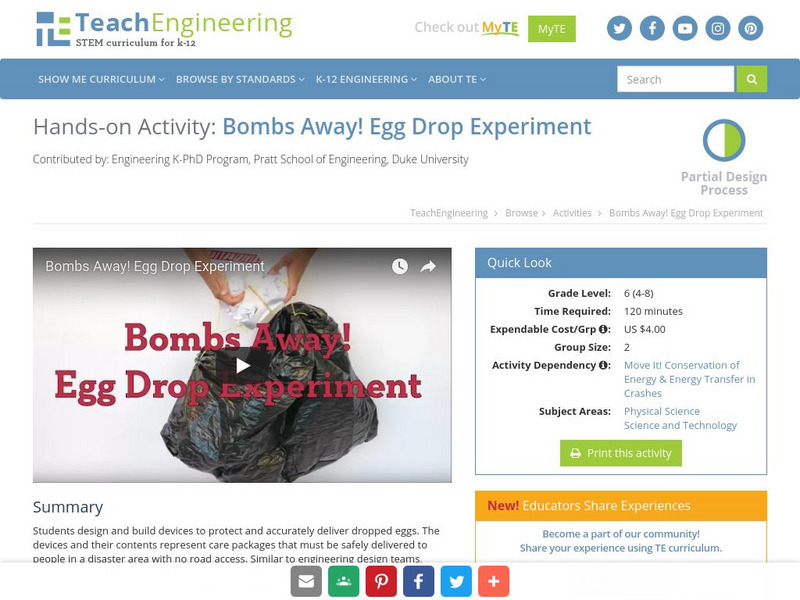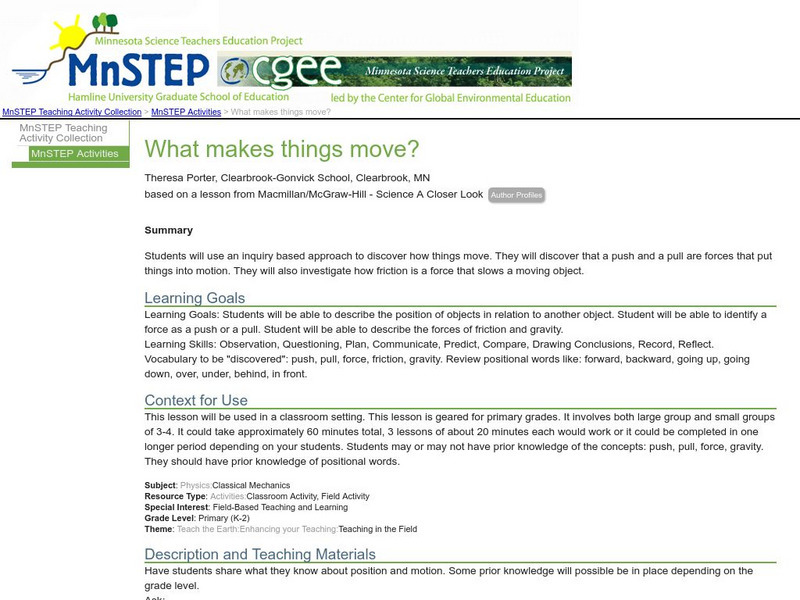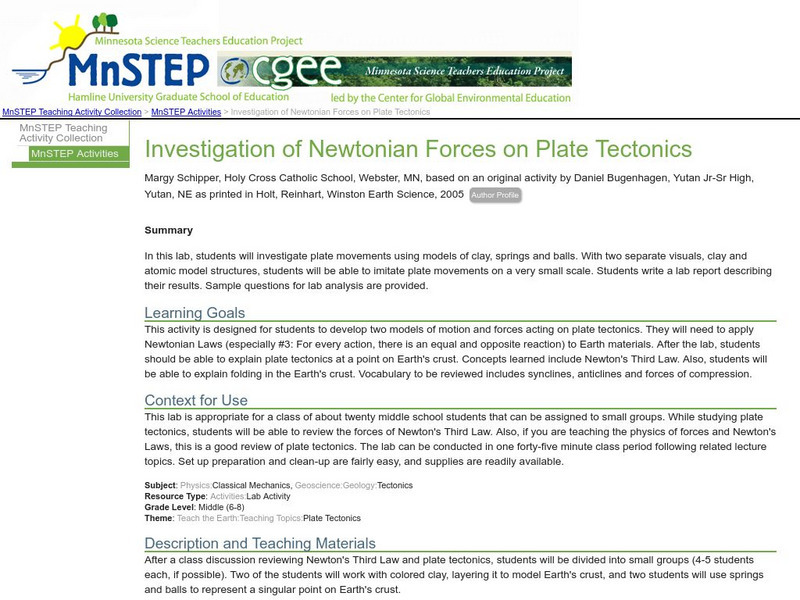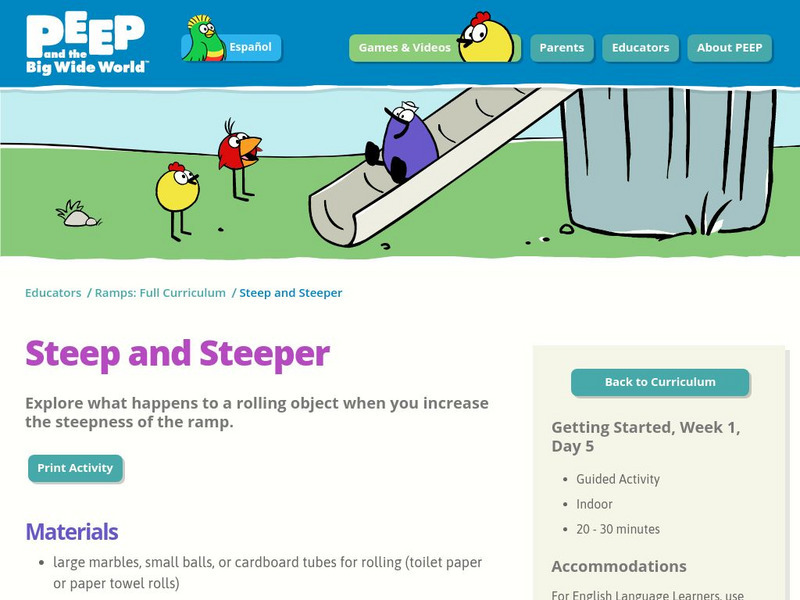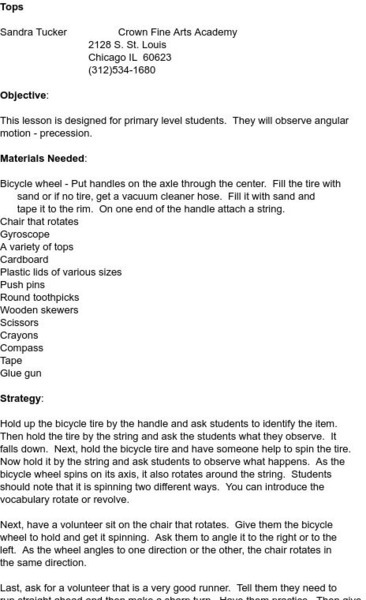Science Education Resource Center at Carleton College
Serc: Investigating the Constancy of Gravity: Free Fall Using a Water Bottle
In this physics interactive lecture demonstration, students will predict what will happen if a plastic bottle, filled with water and having a hole near the bottom, is dropped. Will the bottle fall at the same rate as the water inside the...
TeachEngineering
Teach Engineering: Bombs Away!
In this hands-on activity students learn create a device to protect a dropped egg and deliver it close to a target. Students learn about engineering as well as potential and kinetic energy and energy transfer
TeachEngineering
Teach Engineering: Flocculants: The First Step to Cleaner Water!
Students experience firsthand one of the most common water treatment types in the industry today, flocculants. They learn how the amount of suspended solids in water is measured using the basic properties of matter and light. In...
Science Education Resource Center at Carleton College
Serc: Mn Step: What Makes Things Move?
In this activity, young scholars will learn about push and pull forces that make things move. They will also practice using position words to describe location. To learn about forces, they will move objects, observe the movement of...
Science Museum of Minnesota
Science Museum of Minnesota: Motion Machine
A lesson in which students design a machine that makes motion.
ClassFlow
Class Flow: Motion
[Free Registration/Login Required] This flipchart describes what motion is and what causes an object to move. Streamline videos, activities, and assessment are included.
Science Education Resource Center at Carleton College
Serc: Investigation of Newtonian Forces on Plate Tectonics
An investigation for students to understand plate tectonics by using models to see how motion and forces act on the plates. Students can use these models to see the connection between Newtonian Laws to Earth materials. Lesson plan...
TeachEngineering
Teach Engineering: What Are Newton's Laws?
Through a series of three lessons and one activity, students are introduced to inertia, forces, and Newton's three laws of motion.
TeachEngineering
Teach Engineering: Engineering Out of Harry Situations
Under the "The Science Behind Harry Potter" theme, a succession of diverse complex scientific topics are presented to students through direct immersive interaction. Student interest is piqued by the incorporation of popular culture into...
Science Education Resource Center at Carleton College
Serc: Investigating Projectile Motion: Predicting Point of Impact
Students discuss forces acting on objects in a trajectory motion. They review notes, study equations, solve projectile motion problems, and determine experimentally the impact point of a ball in projectile motion.
Texas Instruments
Texas Instruments: Circular Motion
In UCM, the net force called Fc is equal to mv2/r and is directed toward the center. This is demonstrated by an object that is suspended by a string and is moving in a circular path which makes a conical pendulum. In this experiment, you...
Science Education Resource Center at Carleton College
Serc: Newton's Second Law: How Does Acceleration Change With Varying Forces?
In this lab activity, students investigate the effects of changing force on the acceleration of a lab cart testing Newton's Second Law of Motion. They will use distance and time to calculate velocity and create a graph representing their...
Science Education Resource Center at Carleton College
Serc: Centripetal Force Activity
In this physics activity, students will simulate a race car on a circular track. Velocity, acceleration, and force vectors will be analyzed at various places along the track. As the students progress in the activity, prompts for student...
Science Education Resource Center at Carleton College
Serc: Visualizing Molecules in Motion
In this lab, students will explore the motion of molecules, the forces involved in making them move and predict the level of interaction that molecules can have in order to better understand chemical reactions.
Science Education Resource Center at Carleton College
Serc: Investigating Projectile Motion: Creating a Catapult
This instructional activity is for 9th grade physical science students. It begins with an inquiry-based instructional activity using a projectile motion computer simulation. It culminates with students building a catapult; applying and...
PBS
Wgbh: Peep and the Big Wide World: Down the Slide
Take the students out to the playground so they can explore things that go down the slide.
PBS
Wgbh: Peep and the Big Wide World: Steep and Steeper
Students explore what happens to a rolling object when the steepness of the ramp is increased.
Alabama Learning Exchange
Alex: Experiencing Newton's Laws of Motion
This lesson will approach the study of Newton's 3 Laws of Motion using McGraw-Hill Science textbook Unit F. The students will be given an overview of the laws and vocabulary words to study. After introducing and explaining the concept of...
Physics Classroom
The Physics Classroom: Inertia and Mass
This is part of a lesson on Newton's Laws of Motion that focuses on inertia and mass. It restates Newton's first law of motion. The lesson also gives a helpful visual description concerning friction.
Science and Mathematics Initiative for Learning Enhancement (SMILE)
Smile: Lab Activity: Tops
The Illinois Institute of Technology provides a lab activity on precession and spinning tops. Designed for primary grades, but easily adapted for any level. Includes directions and assessment ideas.
Middle School Science
Middle School Science: Motion Crossword Puzzle
Let your students have a little fun and reinforce their learning of motion-related concepts at the same time.
PBS
Pbs Teachers: Zoom Vehicle
Explore forces of motion and properties of gasses by building a vehicle that runs along a string track powered by air pressure.
Texas Instruments
Texas Instruments: Swing Thing
In this activity, students will construct a pendulum and create a motion plot for a swinging pendulum. They will also identify characteristics that affect a pendulum's motion.
Texas Instruments
Texas Instruments: Shape Up!
In this activity, students can use the motion detector to record motion, and observe how the direction of movement, speed of travel, and the rate of change of direction and speed affect the shape of a distance-time plot.

